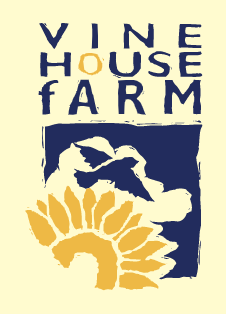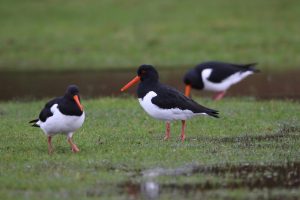
April has certainly been drier than average here, but not the driest. I recorded 11.1mm or nearly half an inch. In April 2007 and 2011, I recorded under 3mm of rain. In 2007, three very wet months followed and in 2011, the weather continued to be dry. So I can’t give any hints as what this summer will be, except the Oak trees are out in leaf before the Ash, which means we are in for a splash, rather than a soak.

Due to the dry weather all farming operations have been carried out on schedule and everything appears to be growing. Early May is sunflower drilling time and, as the seeds are a larger size we can place them quite deeply into the soil to enable them to find the moisture.
The land to be sown with sunflowers and millet has been cultivated and rolled, to conserve the moisture. They are spring crops and need all the growing days we can give them, as they are normally grown in warmer climates. Millet seed is a very small seed, so we cannot sow it very deep and we will probably need to irrigate the fields before we drill them, if there isn’t any rain in the next few days.
Potato prices are dropping for the growers’ stored crop, but I don’t suppose there will be any price reduction in the supermarkets as quite a lot of potatoes are on a price contract. There are many factors which make a surplus, or a shortage, of potatoes and one of those is the weather. If we have an early spring, the early new crop bulk up a week or two earlier, as they will do this spring.
The best crop for wildlife that we grow is oil seed rape. Swans were feeding on it throughout the winter and now up to ten species of birds are holding territory in it and are nesting in the crop. Skylarks and Reed Buntings are the first to start singing in or above the crop, Wrens, Dunnocks and Blackbirds soon follow.
Whitethroats and Sedge Warblers are taking up their territories now; Yellow Wagtails and Reed Warblers will soon follow. When the seed starts to form in the crop, Linnets also move in. After the rape has been harvested and the crop is drilled with winter wheat, you may well see Lapwings and Golden Plover feeding on the field. They will be feeding on the slugs which increase in numbers in the rape crop.
Our second best crop for birds is harvest peas, where up to six species can nest. Harvest peas are those that we allow to die off before they are harvested. They form a tangled crop and nests can easily be concealed in the crop. The peas that farmers round here grow for frozen peas are the worst crop for wildlife, as they are harvested when the birds are nesting and no nests can survive the harvest operation.


Spring and early Summer are magical times of the year with all the birds in full song. Most of our summer visitors are back with us now, I saw my first Swallow on the farm on the 11th April. Reed Warblers are arriving now, which just leaves the Swifts and Spotted Flycatchers which arrive in the first half of May. Turtle Doves did not return to the farm last year. Sand Martins have been busy excavating their nest chambers in our gravel heap for a few weeks now, as they arrived back at the end of March.
Lapwing chicks are hatching on our wetland at Baston Fen. The Lapwings that are nesting on the arable fields are not expected to do well if the dry weather continues as all their food, the worms and the slugs, have burrowed down to keep in the moisture. Lapwings, like most wading birds, are long living birds and should be able to withstand a year of complete failure, as to keep their numbers static, a pair only need to rear one chick per year. The population is declining however, as there is less food available on our farms. We also have more predators than we used to, especially foxes and badgers.
Some Tree Sparrows already have young, we now have 170 nest boxes up and very few are unoccupied. They are very secretive at this time of year as they don’t sing. This is because they don’t have a territory, they go up to 300 yards to collect food for their young and nest communally. If you can attract them to your garden or land they are the most rewarding of birds, as several pairs will nest in a small area. I expect a lot of breeding Tree Sparrows are missed because they do not have a song. A territory is formed to keep other birds of the same species out of that area. If you have a feeding station, territories can get a bit blurred due to invaders. That is why the Robin stands up straight and tall, as if to complain about all the visitors.
The Vine House Farm garden is a hive of activity, with live mealworms the most popular food. We have a good population of Starlings in the village, so to stop the Starlings getting all the live mealworms, I use a Caged Live Food Feeder, available online or in the Farm Shop. I supply soaked sultanas for the Starlings and the Blackbirds, and also provide them with suet.
By offering Starlings this food, their population has still increased locally. Both the suet and soaked sultanas enable the parents to take essential moisture back to their nestlings. This year a Song Thrush has been visiting us for soaked sultanas as he has been unable to get sufficient worms, due to the dry weather.
One or two people have asked me if we have a way of letting the Blackbirds feed without feeding the Starlings. Although we have feeders and protectors to keep out most unwanted guests, we haven’t found a way of preventing Starlings from feeding where Blackbirds can.
Talks, Walks and Events
Saturday 13th May Tree Sparrow Farm Walk
Saturday 20th May Farm Walk
Sunday 11th June Open Farm (Saturday 10th &) Sunday
at Park Farm, Thorney PE6 0SY
Saturday 17th June Farm Walk
Saturday 5th August Sunflower Farm Walk
Saturday 12th August Sunflower Farm Walk
Sunday 13th August Sunflower Farm Walk



